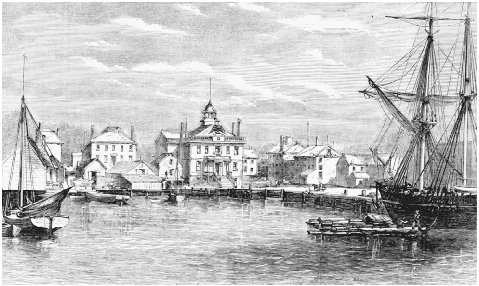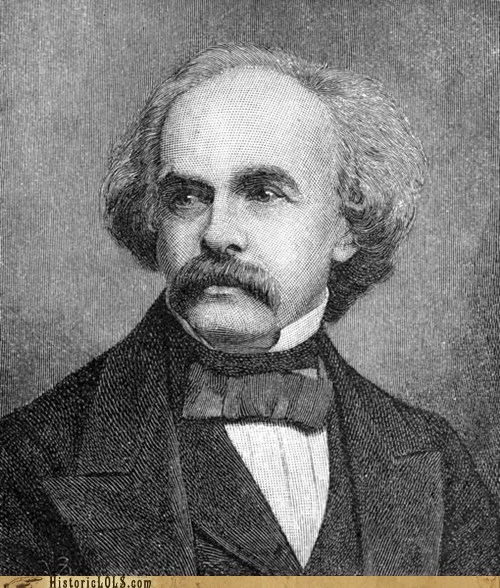You are assigned to read “The Custom House” for DAY 2. This introduction to the novel is a challenging read as Hawthorne’s familiar essay style imbued with his remarkable vocabulary along with the formal voice typical of nineteenth century literature will intimidate, if not, discourage an impatient or tired reader. Skipping “The Custom House” is akin to taking a bath without water as Hawthorne reveals both his motivation for writing the story as well as the remarkable discovery which unleashes the Puritan tale. The study guide questions due on DAY 2 are located at the end of this link.
The Custom House is largely an autobiographical sketch describing the author of The Scarlet Letter Nathaniel Hawthorne’s life as an administrator of the Salem Custom House. It was written to enlarge the tale of The Scarlet Letter, since Hawthorne deemed the story too short to print by itself. It also serves as an excellent essay on society during Hawthorne’s times, and it allows Hawthorne to add an imaginative literary device, the romantic pretense of having discovered the manuscript of The Scarlet Letter in the Custom House.
“The Custom-House” is a stand-alone section of the novel. It resembles more a tract or a personal essay than an introduction to a piece of fiction, but it offers plenty of insights that will support the rest of The Scarlet Letter. For one thing, we gain a sense of why the narrator feels the need to tell the story. As a man of youth and vigor, he feels somewhat at odds with the Puritan nature of his society. He himself seems to feel a deep resentment for the strict fidelity to rules and values that would deem his whole personality, and his ambition to write, as frivolous or even sinful.
Though we cannot necessarily conflate the narrator of “The Custom-House” with Hawthorne himself, despite their biographical similarities, we can observe the tension that both feel in their frustrations of having to choose between their art and their livelihood: “In short, the almost torpid creatures of my own fancy twitted me with imbecility, and not without fair occasion. It was not merely during the three hours and a half which Uncle Sam claimed as his share of my daily life, that this wretched numbness held possession of me.” There seems to be a conflict raging internally, preventing the author from beginning his story. It goes beyond not having time to write. Instead, the question is whether the story is worth telling in the writer’s society. This reflection provides a literary answer about the significance of “The Custom-House”: it adds import and weight to the story to come. The narrator is suggesting that the story goes against the social mores that preserve order among the people. Having to go his own way as a writer, but stuck in his desk job, the narrator worries about losing his muse, worrying that he has “ceased to be a writer of tolerably poor tales and essays, and had become a tolerably good Surveyor of the Customs.” He has the suspicion that his intellect has been “dwindling away,” so much that the story of The Scarlet Letter would no longer be possible for him to write. The act of writing the novel, then, is itself an act of resistance against the increasing solipsism of his own nature, as well as against a society that would banish the artist as decadent or unproductive in a commercialized society.
The narrator notes that upon losing his job as the Customs purveyor, his soul finally broke free, allowing him to write the story of The Scarlet Letter and fulfill his true calling. Indeed, he cannot even remember his days of being at The Custom House, despite it being not too long ago. It is as if once he finally began doing what he was meant to do, his mind erased all the time he wasted, all the resentment that he associated with “Uncle Sam,” who sucked away his passion and imagination. Still, he laments that in this community, he will never be afforded the respect he thinks he deserves as a writer and will never be welcomed genially. Instead, he is a citizen of “somewhere else,” figuring that his “good townspeople will not much regret” him.
Certainly a reader requires some adjustment to Hawthorne’s highbrow language in this chapter. It is remarkably ornate, laden with adjectives and adverbs, and with rich vocabulary. More stifling at times, however, is the interiority of the prose. That is, Hawthorne is more concerned with feelings, thoughts, and emotions than with the unfolding of a real-time story, reflecting a romantic turn after the classical prose of the late eighteenth century. Indeed, the sin of adultery has long since been committed by the time we arrive at the first page of the narrative proper. A number of critics argue that this style presents one of the first examples of distinctly American writing, with its own history and stories and language.
Perhaps the most compelling occurrence in “The Custom-House” comes when the narrator discovers a scarlet letter on a small piece of cloth along with the set of papers that become the foundation of his novel. In an almost fantastical moment, the narrator puts the letter to his breast, prompting an explosion of heat and feeling. In this single recollection, the narrator establishes why the story must be told and why we the reader want to hear it: there is an innate power in that scarlet letter which must be unlocked, which demands to be heard. The story, the letter—neither is dead. This device has been used commonly in literature—that is, when someone discovers an ancient artifact, it retains some of its power, and the finder has the responsibility to put it to rest. In this case the narrator, despite his torpid slumber of insipid duty to job and country, has been awakened to his mission, and he accepts it, revealing to us the mystery of the letter, no matter the consequences for him and his community.
Study Guide “The Custom House”
1. What is the Old Manse?
2. It has been said by Salemites that Hawthorne’s description of the custom house and the town is “sour
grapes”; that is, he described the town in such a dismal manner because he was angry over having been
ousted from the job at the Custom House. Identify three examples from the text that supports this. (Cite
page number)
3. How does Hawthorne believe his ancestors would have perceived him? (10)
4. What is Hawthorne’s attitude towards his co-workers?
5. Who is the Surveyor?
6. Who is Pue?
7. What does his ghost make Hawthorne promise?
8. Besides the ghost, how does Hawthorne create a supernatural mood with the scarlet
letter?
9. Who is Hester Prynne?
10. What is the time period of her story?
11. Discuss the use of lighting on page 35.
12. Hawthorne states, “The sketch which I am now bringing to a close, if too
autobiographical for a modest person to publish in his lifetime will readily be excused
in a gentleman who writes from beyond the grave” Who is the gentleman? What does
this explain?


